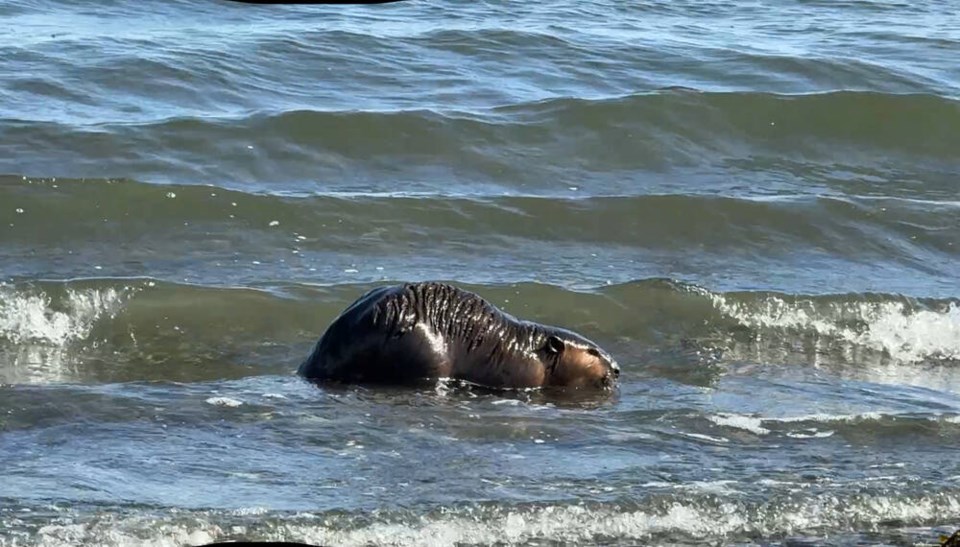They might be known as industrious and resilient animals, found in streams nearly everywhere in the country.
But castor canadensis — the web-footed, flat-tailed, buck-tooth mammal that graces the back of our nickel — simply cannot survive in salt water.
That was certainly true for an adult female beaver discovered in the ocean surf near Reay Creek in the Sidney area last weekend.
Siobhan Bibb was walking with her husband and photographing birds on Saturday when she noticed what she thought was an otter a few metres offshore. Zooming in with her camera, she saw it was a beaver, and it wasn’t looking well.
“First thing I thought was: What’s a beaver doing in the ocean? Am I crazy?” said Bibb. “It was moving its way along the shore very slowly, very listless.”
Bibb was getting ready to send her photos to the B.C. SPCA’s Wild Animal Rehabilitation Centre in Metchosin when she learned some nearby residents had already called the animal rescue agency.
They had brought a dog crate to the beach and were protecting the beaver from the dogs that are often off-leash in the area.
WILDArc collected the beaver, and confirmed it had been suffering from hypothermia and dehydration due to saltwater toxicity. The animal was euthanized after it failed to respond to treatment the following day.
It isn’t known how long the beaver had been in salt water, but Bibb said there were reports of a beaver the day before off downtown Sidney and farther north at Roberts Bay.
Gavin Hanke, curator of vertebrate zoology at the Royal B.C. Museum, said prolonged exposure to and ingestion of salt water doesn’t end well for most mammals because of severe dehydration.
He said there’s evidence of that in everything from sailors involved in boat sinkings during the Second World War to other mammals like beavers not evolved to live in marine environments.
“Some mammals have the physiology to handle salt water. River otters, for example, can. But beavers don’t.”
Henke said he hears of several cases a year where beavers kicked out of their ponds and looking for their own territories end up in freshwater streams that lead to the ocean.
He’s taken in two beaver specimens for the museum over the past two years, including one from the Powell River area last spring.
The American Museum of Natural History says seawater is about 3.5% salt by weight and ingesting it causes dehydration because the amount of water needed to flush the extra salt would be more than you can drink.
However, some animals that live in or near the ocean have developed the ability to pump out the extra salt while keeping water levels in balance. Whales, for example, can filter out seawater and obtain metabolic water from the food they eat.
Jenna Kuncewicz, senior wildlife supervisor at Critter Care Wildlife Society in Langley, said the group gets eight to 10 rescue calls a year for beavers in salt water, usually in the spring, and few survive.
“It’s very, very rare they make it,” she said in an interview. “Generally, once we find them and get them out of the water, they’ve ingested so much sea water that it’s almost impossible to treat.”
She said beavers’ kidneys aren’t able to filter out all the salt in their systems, which causes the animals to slowly shut down. “We see severe dehydration and neurological effects that makes them act drunk, lethargic, and they lack appetite.”
In some cases, beavers have been nursed back to health, but it usually depends on how long they’ve been ingesting salt water and how quickly they are reported and rescued, Kuncewicz said.
“They can maybe last for two or three days and that’s when they either wash up on shore [dead] or come to the shore and are pretty severely poisoned by that point.”
Reviving the beavers is a fine balance, she said. “You can’t hydrate them too quickly. You can dilute the salt levels with fluids, but they can go into shock. When it’s at a severe point — that’s when we get most of them — treatment usually isn’t viable and it’s a high mortality rate.”
Kuncewicz said as two-year-old beavers move out from their birth dams, new habitats are harder to find and that often leads to streams that end in the ocean.
A beaver found in Tsawwassen this week was collected but died. Two others showed up off the seawall in Stanley Park last week.
“We experience so much despair surrounding any wild animal … the beavers are super important for ecosystems, a national symbol. It’s hard when you’re trying everything, but can’t save them,” said Kuncewicz. “The saltwater beavers have such a low success rate, so that makes it quite sad.”
To report an animal in distress, call the B.C. SPCA Animal Helpline at 1-855-622-7722.



